Mechanical Properties of Dahurian Larch Wood under Cyclic Loading: Experiments and Constitutive Model
Abstract
:1. Introduction
2. Materials and Methods
2.1. Material and Specimens
2.2. Loading Scheme
3. Test Results and Analysis
3.1. Failure Mode
3.1.1. Parallel-to-Grain Tension
3.1.2. Parallel-to-Grain Compression
3.1.3. Perpendicular-to-Grain Tension and Compression
3.2. Stress–Strain Curves
3.2.1. Monotonic Stress–Strain Curves
3.2.2. Cyclic Stress–Strain Curves
4. Constitutive Model of Wood
4.1. Monotonic Constitutive Model
4.1.1. Parallel-to-Grain Tension
4.1.2. Parallel-to-Grain Compression
4.1.3. Perpendicular-to-Grain Constitutive Model
4.2. Envelope Curve
4.2.1. Parallel-to-Grain Envelope Curve
4.2.2. Perpendicular-to-Grain Skeleton Curve
4.3. Hysteresis Curve
4.3.1. Parallel-to-Grain Cyclic Model
- In the process of cyclic loading and unloading, both tension and compression unloading are expressed linearly by the corresponding unloading curve.
- After wood is unloaded under tension and compression, the reloading curve is described by the forward reloading model and the reverse reloading model, respectively.
- In the forward reloading model, the stress returns to the unloading starting point along the unloading curve and then continues to load according to the skeleton curve, while the reverse reloading model points to the skeleton curve in the opposite direction.
- At the unloading point, the strain and the corresponding irreversible deformation are small. The reverse reloading curve is usually assumed to continue loading along the reverse skeleton curve after loading along the strain axis (the stress is always 0) to the strain zero point.
- The tension skeleton curve implicitly considers the stress drop phenomenon and uses the smooth curve to express it, while the reverse tension reload curve explicitly describes the stress drop phenomenon.
- Compression and tension unloading models;
- 2.
- Reverse compression reloading model;
- 3.
- Reverse tension reloading model.
- When (considering stress drop), Equation (10) is adopted, and the relevant parameters are a drop point strain of 0.038 and a drop stress of 27.3 MPa. The values of the other parameters are = −8.1 MPa, = 11.7, and = 32.6.
- When (without considering the stress drop), the first formula in Equation (10) is used, and the relevant parameters are = −10.7 MPa, = 15.8, and = 32.0.
- In the third stage, when the strain at the compression unloading point is less than −0.05, the reload curve is characterized by the first formula of Equation (10), and the corresponding parameter values are = −4.52 MPa, = 7.14 MPa, and = 81.34.
4.3.2. Perpendicular-to-Grain Cyclic Model
- Strain analysis of critical control points;
- 2.
- Compression unloading model;
- 3.
- Reverse tensile stress–strain model;
- 4.
- Tensile unloading stress–strain model;
- 5.
- Reverse compressive stress–strain model.
5. Verification of the Constitutive Model
6. Conclusions
- The main stress characteristics of monotonous and cyclic tension along the grain of wood are random fractures in different positions and different quantities of wood fibers after the peak point. The random drop in stress and the continuous loading mechanism based on the remaining effective section of wood until the specimen was completely broken were observed. In the process of cyclic tension, the loading and unloading of wood is coupled with a random drop in stress.
- There are two failure modes of wood observed under parallel-to-grain cyclic compression, namely buckling and shear. The stress–strain curve with the former failure characteristic shows that the stress after the peak point decreases smoothly and slowly with the increase in load, and the specimen has two damage bands. The stress–strain curve of the latter shows that the stress decreases suddenly and then rises slowly, and there is one kinking and torsion damage zone in the specimen.
- The complete stress–strain curve of wood under perpendicular-to-grain cyclic loading is significantly asymmetrical and converges from the compression side to the tension side. The compression unloading curve shows significant nonlinear stress characteristics, and irreversible deformation and unloading stiffness degradation are evident. There is an inflection point in the reverse compression stress–strain curve after unloading to zero under tension, which changes from convex to concave, and the stiffness degrades.
- Based on the test results of wood under parallel- and perpendicular-to-grain cyclic loading, the stress–strain model that can consider the degradation of cyclic compression unloading stiffness and the change in reverse compression (tension) stiffness after tension (compression) unloading is established. The model results are in good agreement with the test results.
- Although the proposed constructed constitutive model is able to describe the complex mechanical performance of wood in both the longitudinal and transverse directions under uniaxial and cyclic loading, there are still two aspects that need to be improved in the future. Firstly, the revelation of the damage mechanism of wood under different loading cases needs to be investigated. The second issue is to describe the hysteresis behavior of wood within the framework of damage mechanics and implement it into ABAQUS 6.14 software to provide support for nonlinear analysis of timber components and structures.
Author Contributions
Funding
Data Availability Statement
Conflicts of Interest
References
- Xie, Q.F.; Zhang, L.P.; Li, S.; Zhou, W.J.; Wang, L. Cyclic behavior of Chinese ancient wooden frame with mortise–tenon joints: Friction constitutive model and finite element modelling. J. Wood Sci. 2018, 64, 40–51. [Google Scholar] [CrossRef]
- Xie, Q.F.; Zhang, L.P.; Miao, Z.; Zhou, W.J. Lateral behavior of traditional Chinese timber frames strengthened with shape memory alloy: Experiments and analytical model. J. Struct. Eng. 2020, 146, 04020083. [Google Scholar] [CrossRef]
- Hua, Y.W.; Chun, Q. Influence of Pu-zuo on progressive collapse behavior of ancient southern Chinese timber buildings built in the Song and Yuan dynasties: Experimental Research. Eng. Fail. Anal. 2022, 137, 137. [Google Scholar] [CrossRef]
- Babanc, M.B. Examination of the failures and determination of intervention methods for historical Ottoman traditional timber houses in the Cumalkzk Village, Bursa-Turkey. Eng. Fail. Anal. 2013, 35, 470–479. [Google Scholar]
- He, J.X.; Wang, J. Theoretical model and finite element analysis for restoring moment at column foot during rocking. J. Wood Sci. 2018, 64, 97–111. [Google Scholar] [CrossRef]
- Vazquez, C.; Gonçalves, R.; Bertoldo, C.; Baño, V.; Vega, A.; Crespo, J.; Guaita, M. Determination of the mechanical properties of castanea sativa mill. using ultrasonic wave propagation and comparison with static compression and bending methods. Wood Sci. Technol. 2015, 49, 607–622. [Google Scholar] [CrossRef]
- Bachtiar, E.V.; Sanabria, S.J.; Mittig, J.P.; Niemz, P. Moisture-dependent elastic characteristics of walnut and cherry wood by means of mechanical and ultrasonic test incorporating three different ultrasound data evaluation techniques. Wood Sci. Technol. 2017, 51, 47–67. [Google Scholar] [CrossRef]
- Jiang, J.L.; Bachtiar, E.V.; Liu, J.X.; Niemz, P. Comparison of moisture-dependent orthotropic young’s moduli of chinese fir wood determined by ultrasonic wave method and static compression or tension tests. Eur. J. Wood Wood Prod. 2018, 76, 953–964. [Google Scholar] [CrossRef]
- Oudjene, M.; Khelifa, M. Finite element modeling of wooden structures at large deformations and brittle failure prediction. Mater. Des. 2009, 30, 4081–4087. [Google Scholar] [CrossRef]
- Guan, Z.W.; Zhu, E.C. Finite element modelling of anisotropic elasto-plastic timber composite beams with openings. Eng. Struct. 2009, 31, 394–403. [Google Scholar] [CrossRef]
- Chen, Z.Y.; Zhu, E.C.; Pan, J.L. Numerical simulation of mechanical behaviour of wood under complex stress. Chin. J. Comput. Mech. 2011, 28, 629–634. [Google Scholar]
- Yang, N.; Zhang, L.; Qin, S.J. A nonlinear constitutive model for characterizing wood under compressive load and its test verification. China Civ. Eng. J. 2017, 50, 80–88. [Google Scholar]
- Sandhaas, C. Mechanical Behaviour of Timber Joints with Slotted-in Steel Plates. Ph.D. Thesis, Technische Universiteit, Delft, The Netherlands, 2012. [Google Scholar]
- Gharib, M.; Hassanieh, A.; Valipour, H.R.; Bradford, M.A. Three-dimensional constitutive modelling of arbitrarily orientated timber based on continuum damage mechanics. Finite Elem. Anal. Des. 2017, 135, 79–90. [Google Scholar] [CrossRef]
- Eslami, H.; Jayasinghe, L.B.; Waldmann, D. Nonlinear three-dimensional anisotropic material model for failure analysis of timber. Eng. Fail. Anal. 2021, 130, 105764. [Google Scholar] [CrossRef]
- Arruda, M.R.T.; Trombini, M.; Pagani, A. Implicit to Explicit Algorithm for ABAQUS Standard User-Subroutine UMAT for a 3D Hashin-Based Orthotropic Damage Model. Appl. Sci. 2023, 13, 1155. [Google Scholar] [CrossRef]
- Sirumbalzapata, L.F.; Málagachuquitaype, C.; Elghazouli, A.Y. A three-dimensional plasticity-damage constitutive model for timber under cyclic loads. Comput. Struct. 2017, 195, 47–63. [Google Scholar] [CrossRef]
- Wang, M.Q.; Song, X.B.; Gu, X.L. Three-Dimensional Combined Elastic-Plastic and Damage Model for Nonlinear Analysis of Wood. J. Struct. Eng. 2018, 144, 04018103. [Google Scholar] [CrossRef]
- Benvenuti, E.; Orlando, N.; Gebhardt, C.; Kaliske, M. An orthotropic multi-surface damage-plasticity FE-formulation for wood: Part I—Constitutive model. Comput. Struct. 2020, 240, 106350. [Google Scholar] [CrossRef]
- Zhang, L.P.; Xie, Q.F.; Zhang, B.Z.; Wang, L.; Yao, J.T. Three-dimensional elastic-plastic damage constitutive model of wood. Holzforschung 2021, 75, 526–544. [Google Scholar] [CrossRef]
- Chen, Z.Y.; Ni, C.; Dagenais, C.; Kuan, S. A temperature-dependent plastic-damage constitutive model, woodst, for numerical simulation of wood-based materials and connections. J. Struct. Eng. 2019, 146, 04019225. [Google Scholar] [CrossRef]
- Jiang, S.F.; Qiao, Z.H.; Wu, M.H.; Ouyang, Q. Study on wooden constitutive model considering long-term effects of environment and load. J. Build. Struct. 2021, 42, 160–168. [Google Scholar]
- Zhang, L.P.; Xie, Q.F.; Liu, Y.J.; Zhang, B.Z.; Wu, Y.J. Elastic-plastic damage constitutive model and numerical implementation for timber considering seismic strain rate effects. Chin. Civ. Eng. J. 2022, 56, 22–31. [Google Scholar]
- Yu, T.; Khaloian, A.; Jan-Willem, V.D.K. An improved model for the time-dependent material response of wood under mechanical loading and varying humidity conditions. Eng. Struct. 2022, 259, 114116. [Google Scholar] [CrossRef]
- Xie, Q.F.; Zhang, L.P.; Wang, L.; Wu, F.F. Research on radial stress-strain model of wood under repeated compressive loading. J. Hunan Univ. Nat. Sci. 2018, 45, 55–61. [Google Scholar]
- Edzang, A.C.E.; Nziengui, C.F.P.; Ango, S.E.; Ikogou, S.; Pitti, R.M. Comparative studies of three tropical wood species under compressive cyclic loading and moisture content changes. Wood Mater. Sci. Eng. 2021, 16, 196–203. [Google Scholar] [CrossRef]
- Zhang, C.H.; Liao, H.J.; Qian, C.Y.; Li, H.Z.; Song, L.; Zheng, J.G. Tensile-compressive fatigue experiment of wood of ancient building. Eng. Mech. 2016, 33, 201–206. [Google Scholar]
- GB/T-1927.5. Test Method for Physical and Mechanical Properties of Small Clear Wood Specimens—Part 5: Determination of Density; China Architecture & Building Press: Beijing, China, 2021. (In Chinese)
- GB/T 1927.4. Test Method for Physical and Mechanical Properties of Small Clear Wood Specimens—Part 4: Determination of Moisture Content; China Architecture & Building Press: Beijing, China, 2021. (In Chinese)
- GB/T 1927.3. Test Method for Physical and Mechanical Properties of Small Clear Wood Specimens—Part 3: Determination of the Growth Rings Width and Latewood Rate of Wood; China Architecture & Building Press: Beijing, China, 2021. (In Chinese)
- GB/T 1935. Method of Testing in Compressive Strength Parallel to Grain of Wood; China Architecture & Building Press: Beijing, China, 2009. (In Chinese)
- GB/T 1938. Method of Testing in Tensile Strength Parallel to Grain of Wood; China Architecture & Building Press: Beijing, China, 2009. (In Chinese)
- GB/T 1939. Method of Testing in Compressive Strength Perpendicular to Grain of Wood; China Architecture & Building Press: Beijing, China, 2009. (In Chinese)
- GB/T 1927.5. Test Method for Physical and Mechanical Properties of Small Clear Wood Specimens—Part 2: Sampling Methods and General Requirements; China Architecture & Building Press: Beijing, China, 2021. (In Chinese)
- GB 50005. Standard for Design of Timber Structures; China Architecture & Building Press: Beijing, China, 2017. (In Chinese)


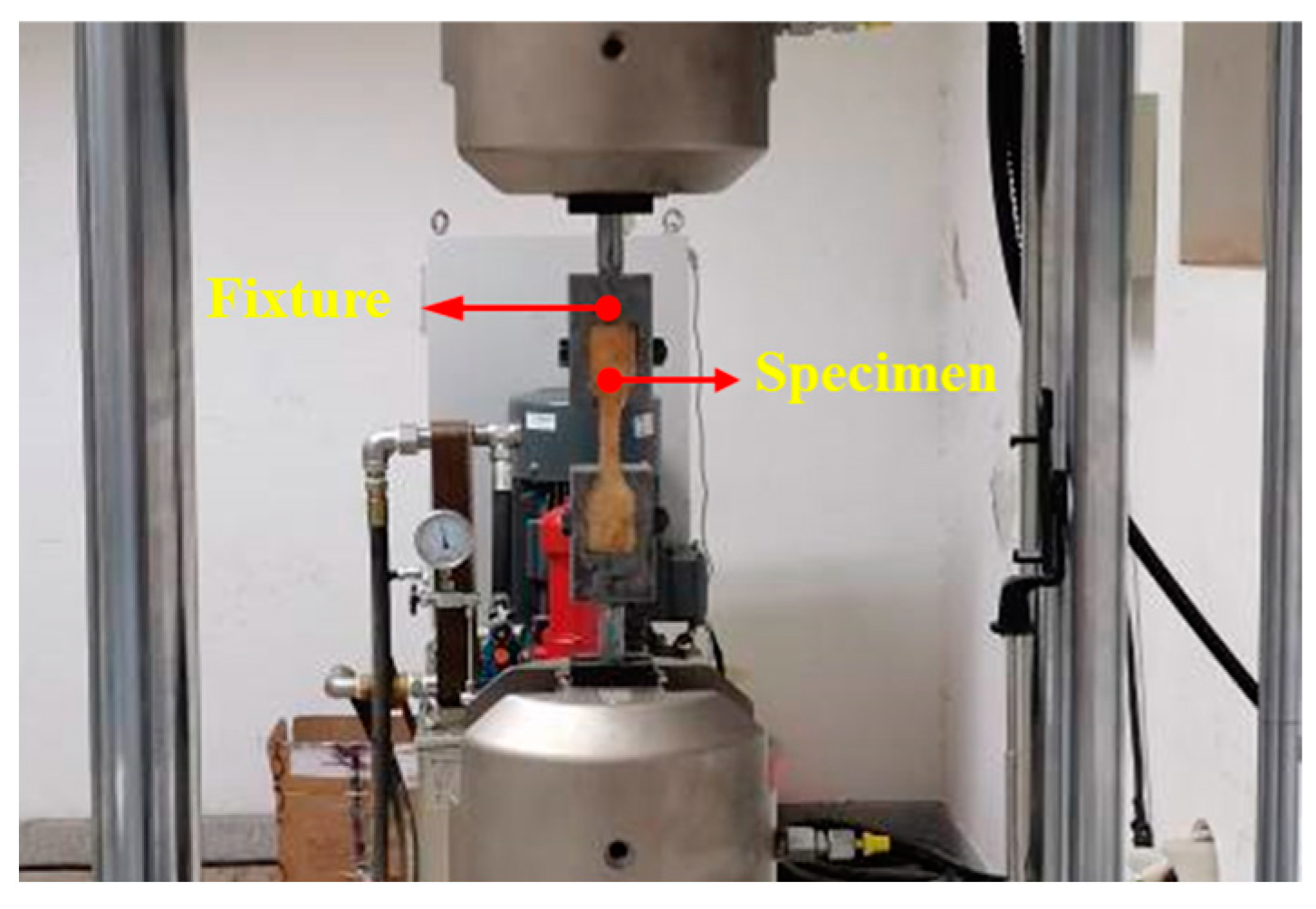
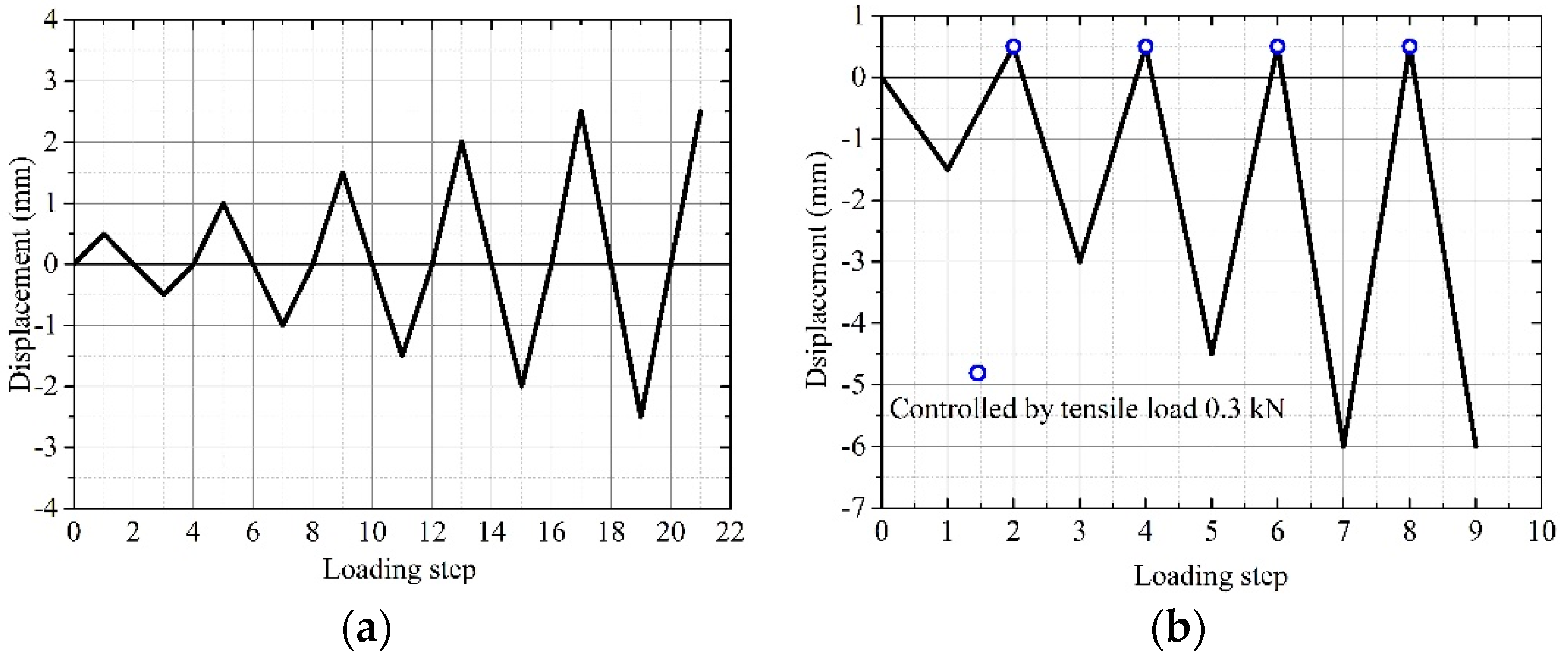

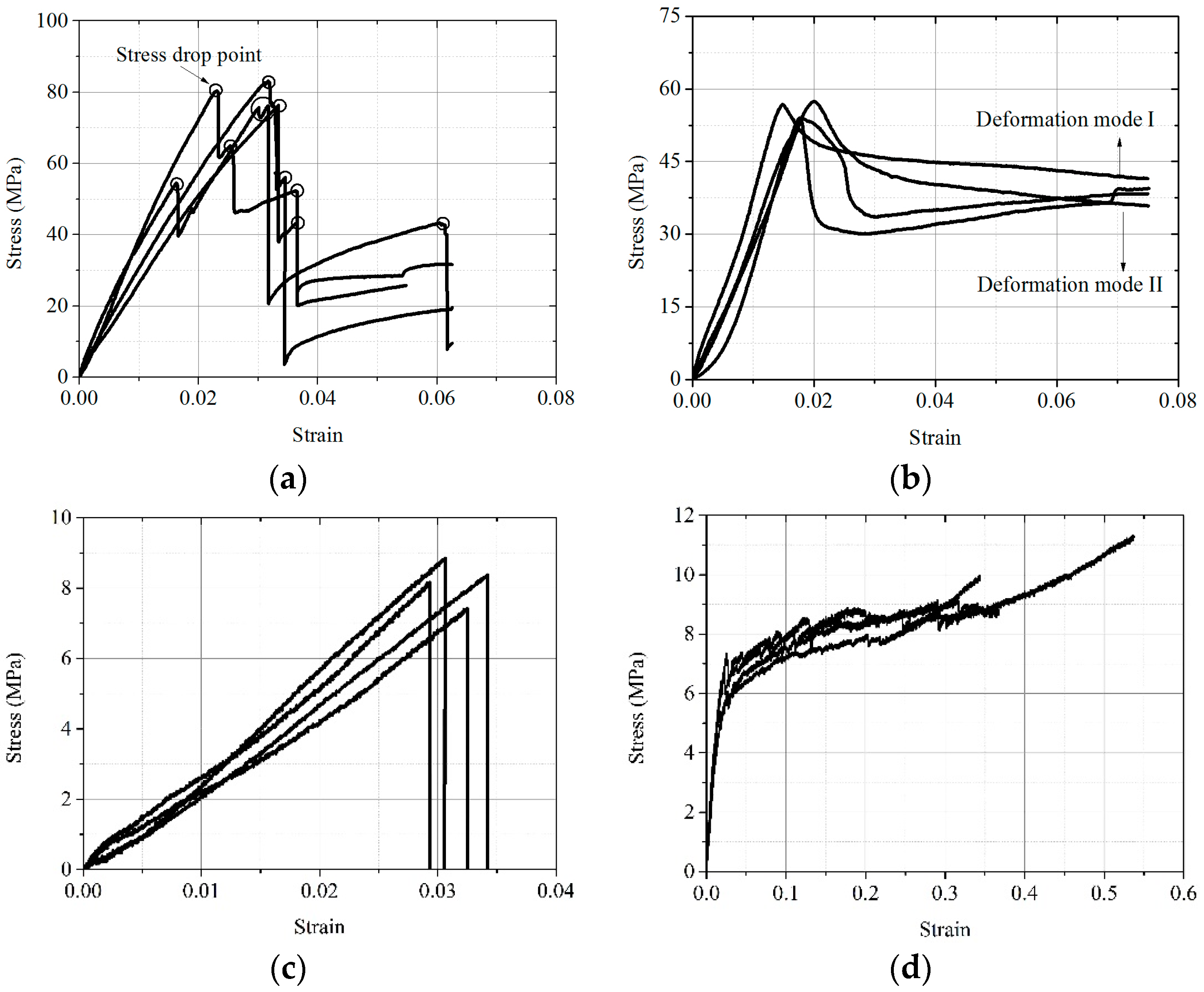
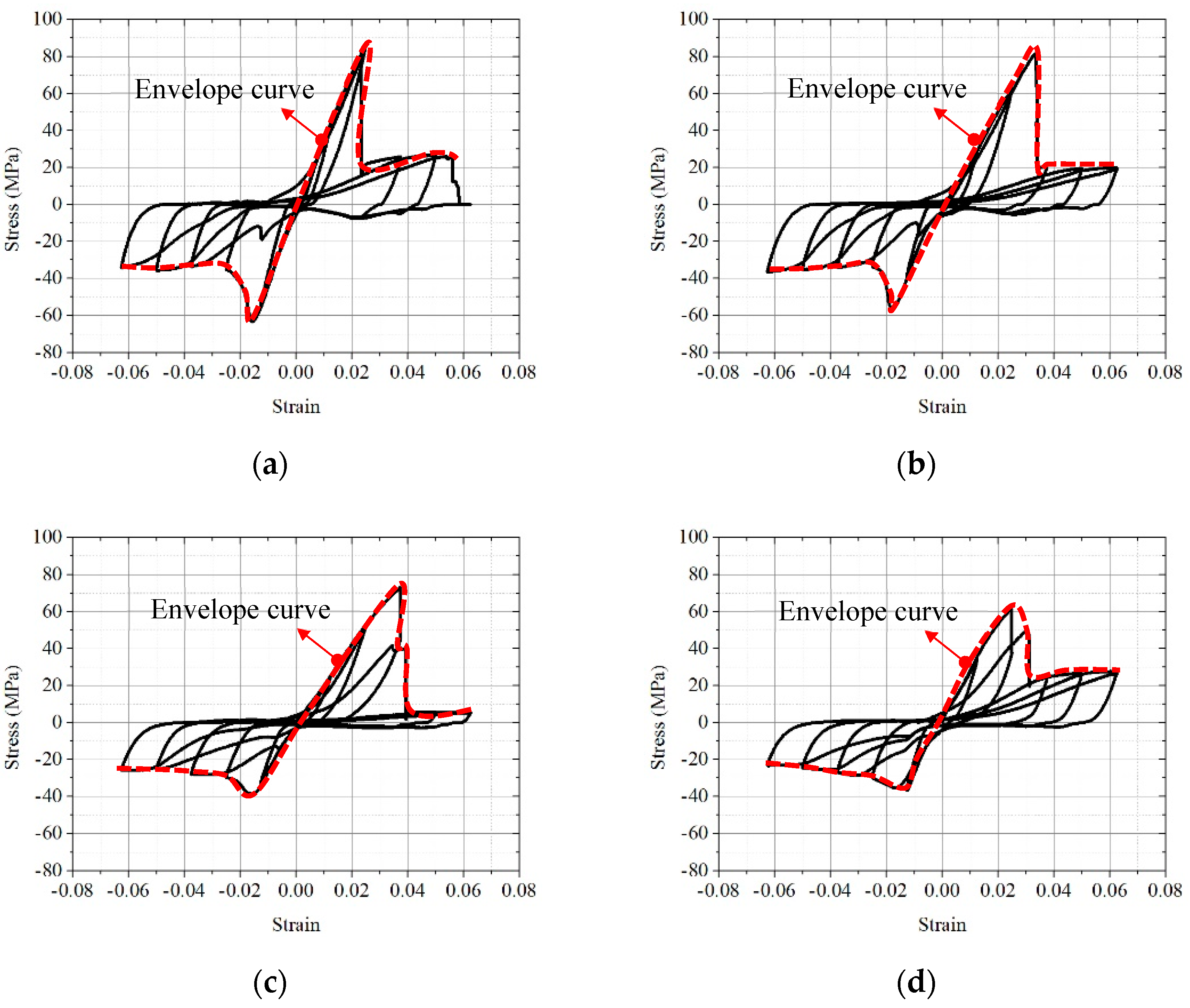
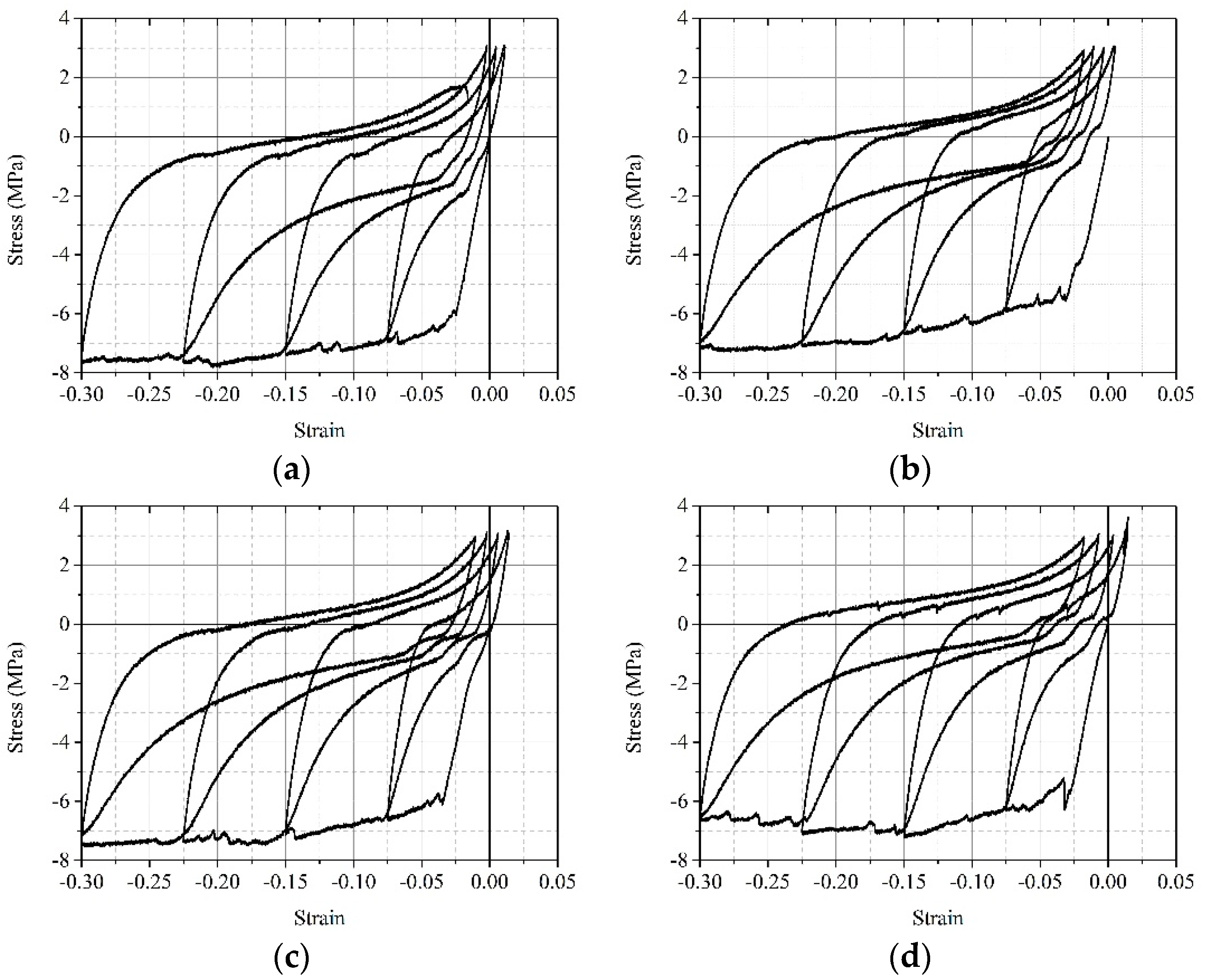
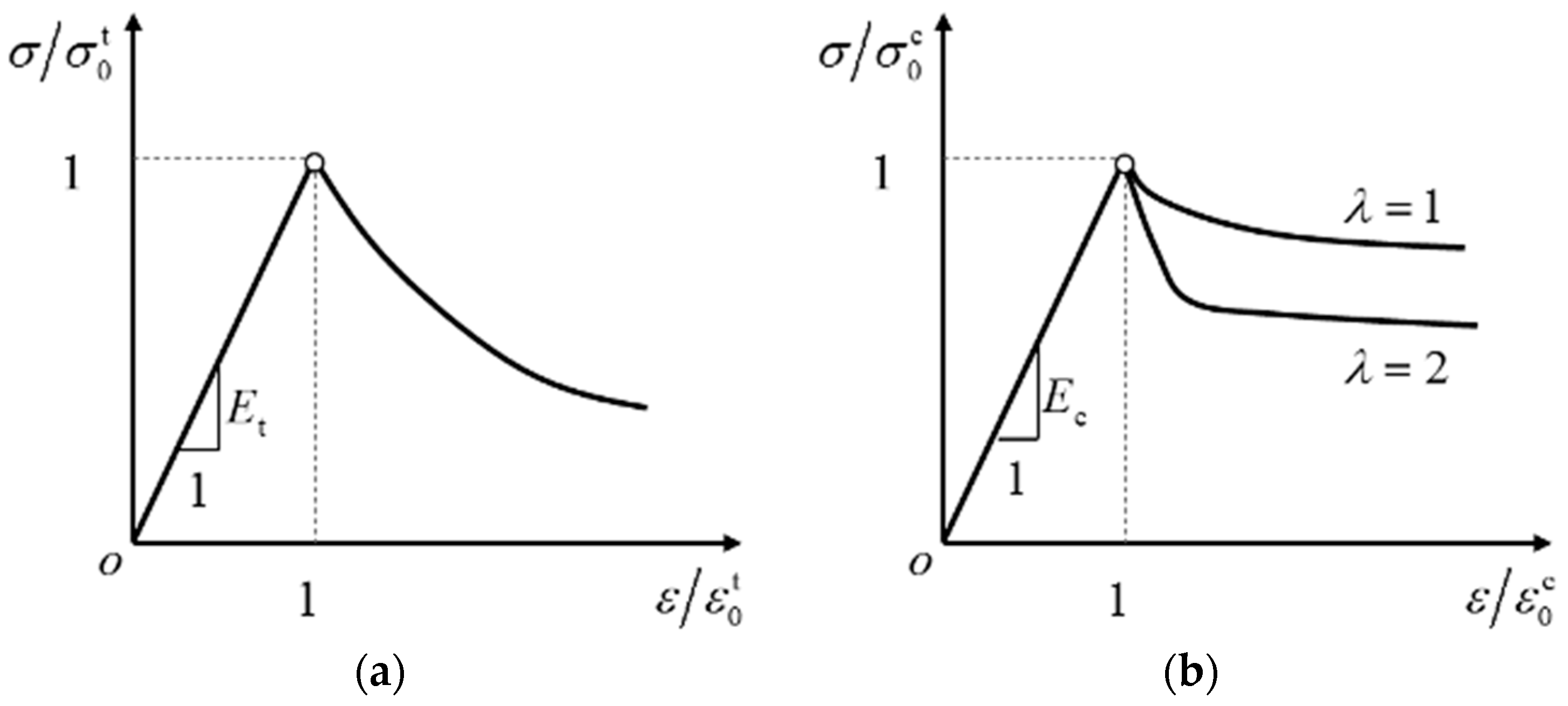

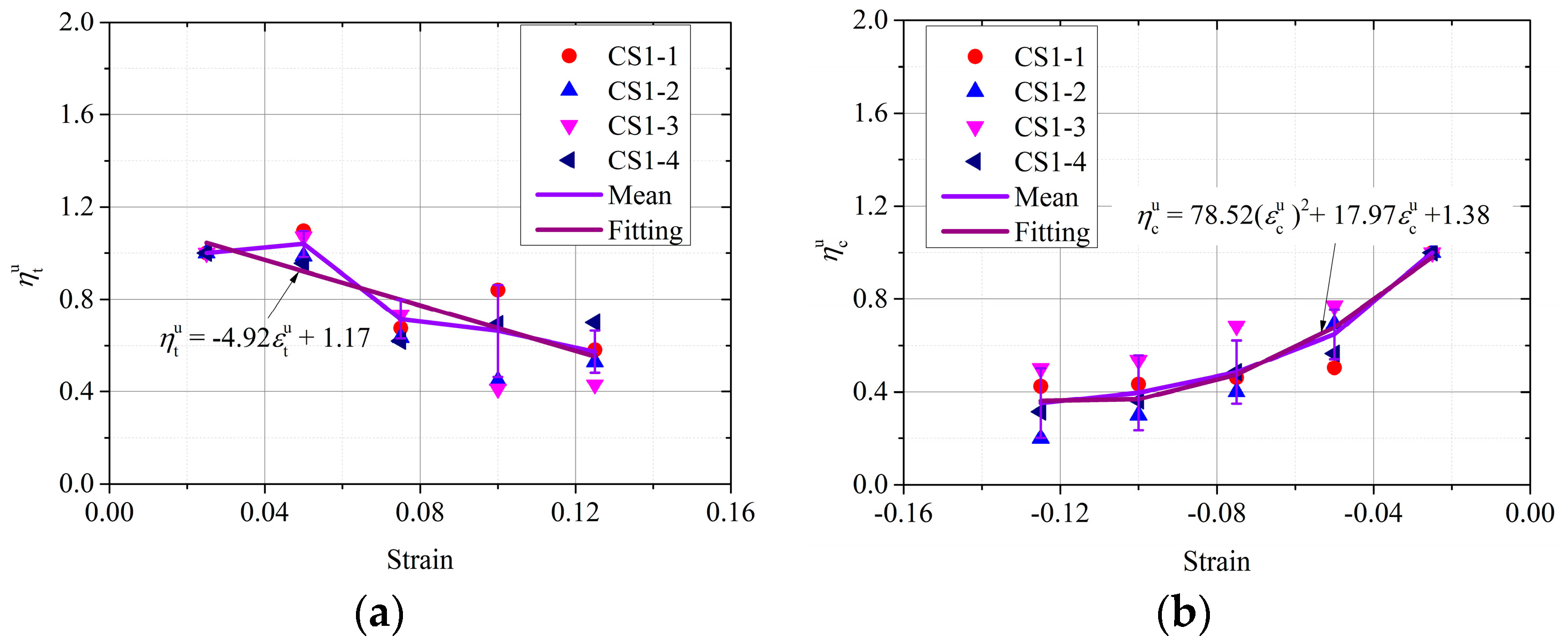
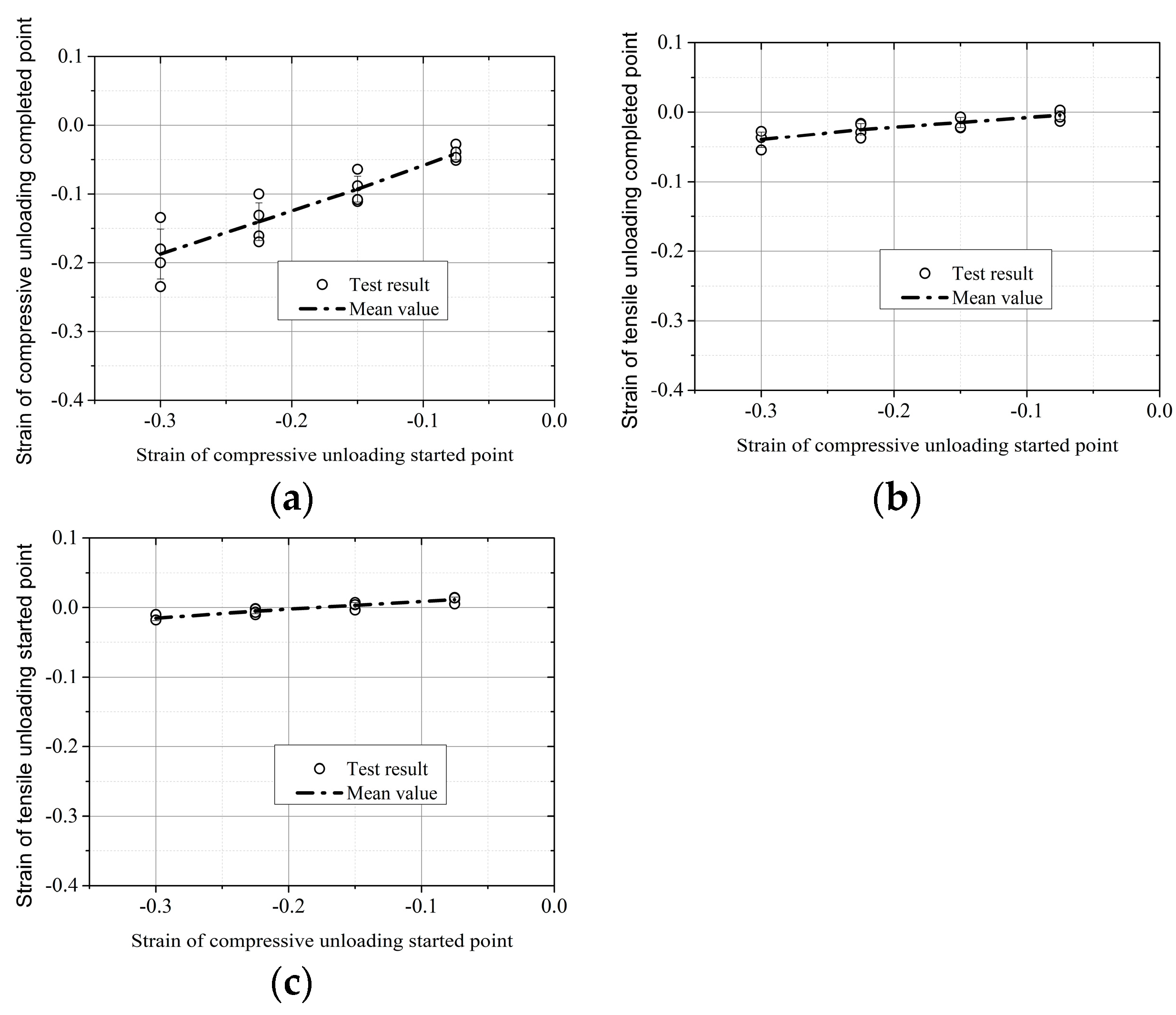

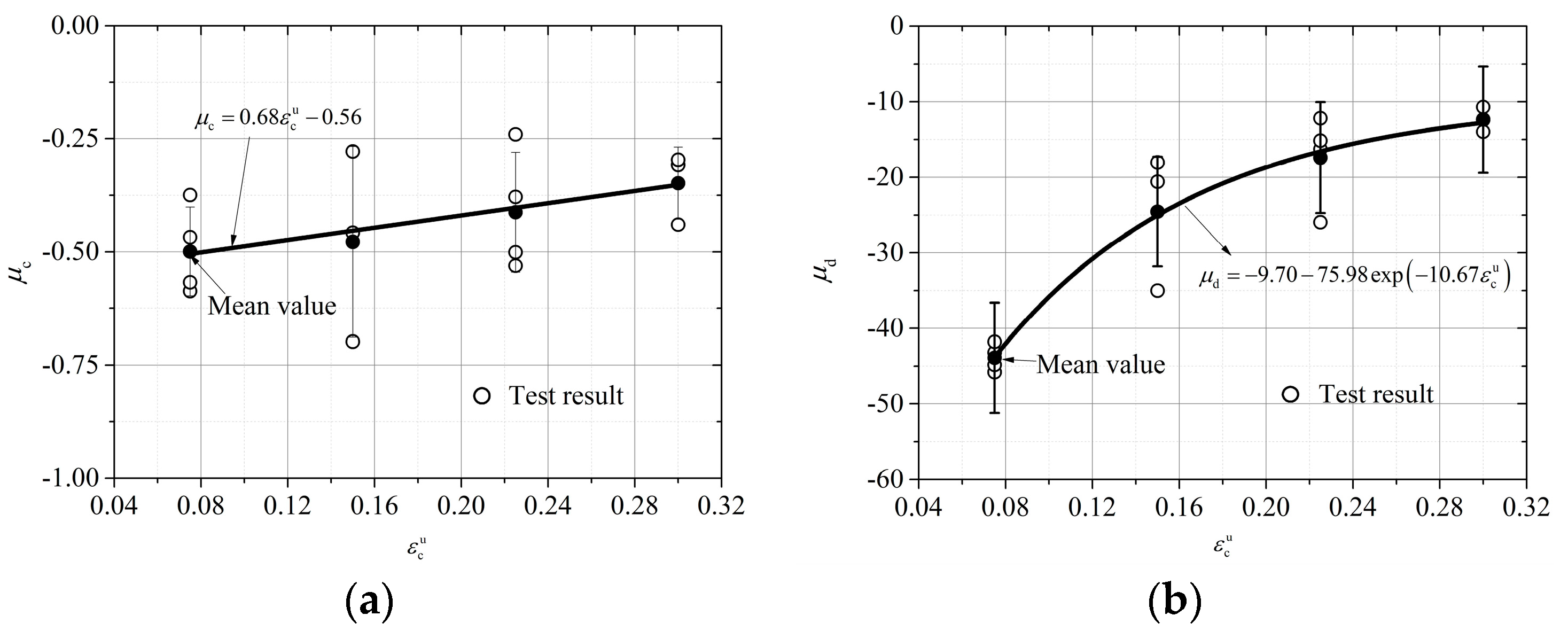
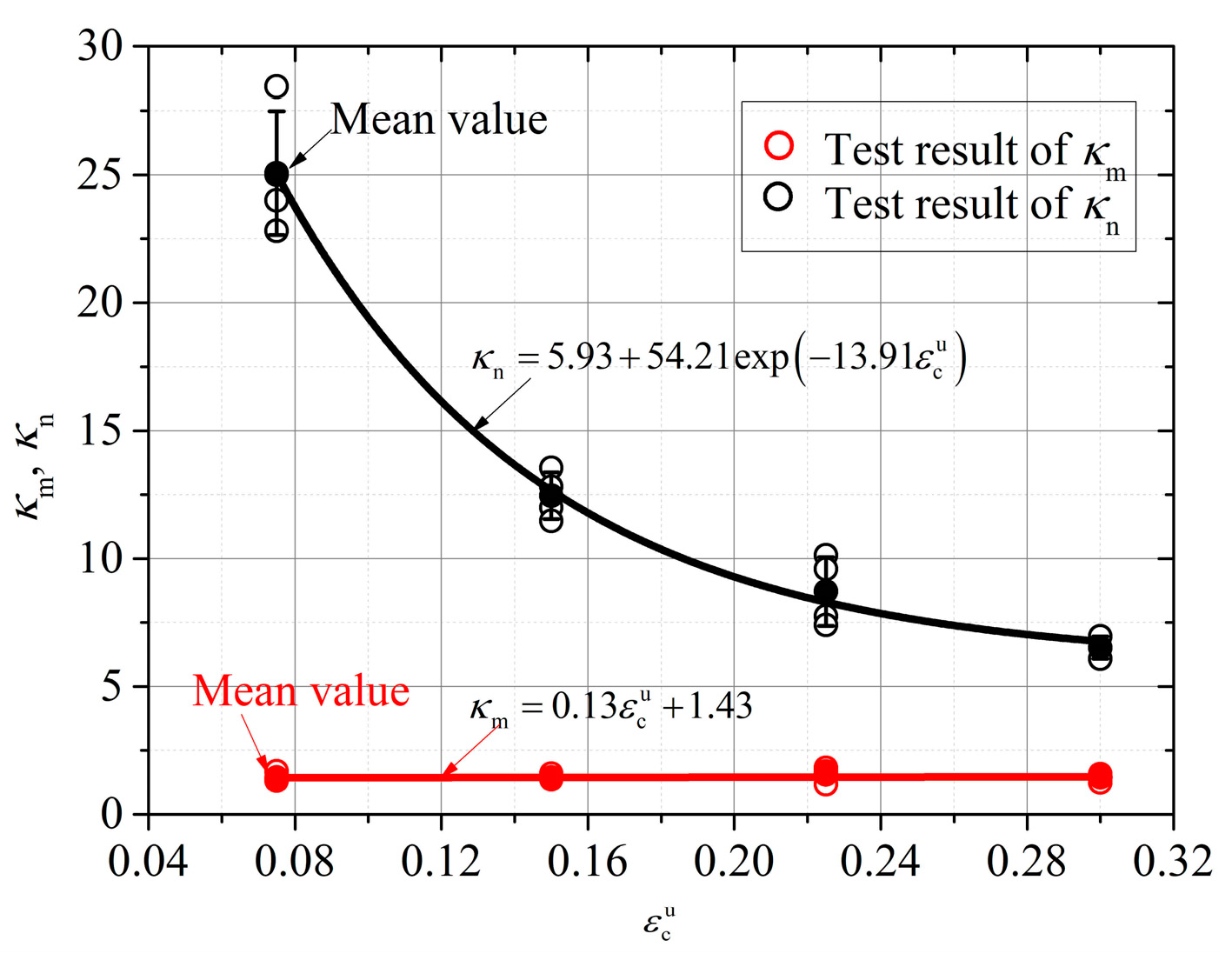
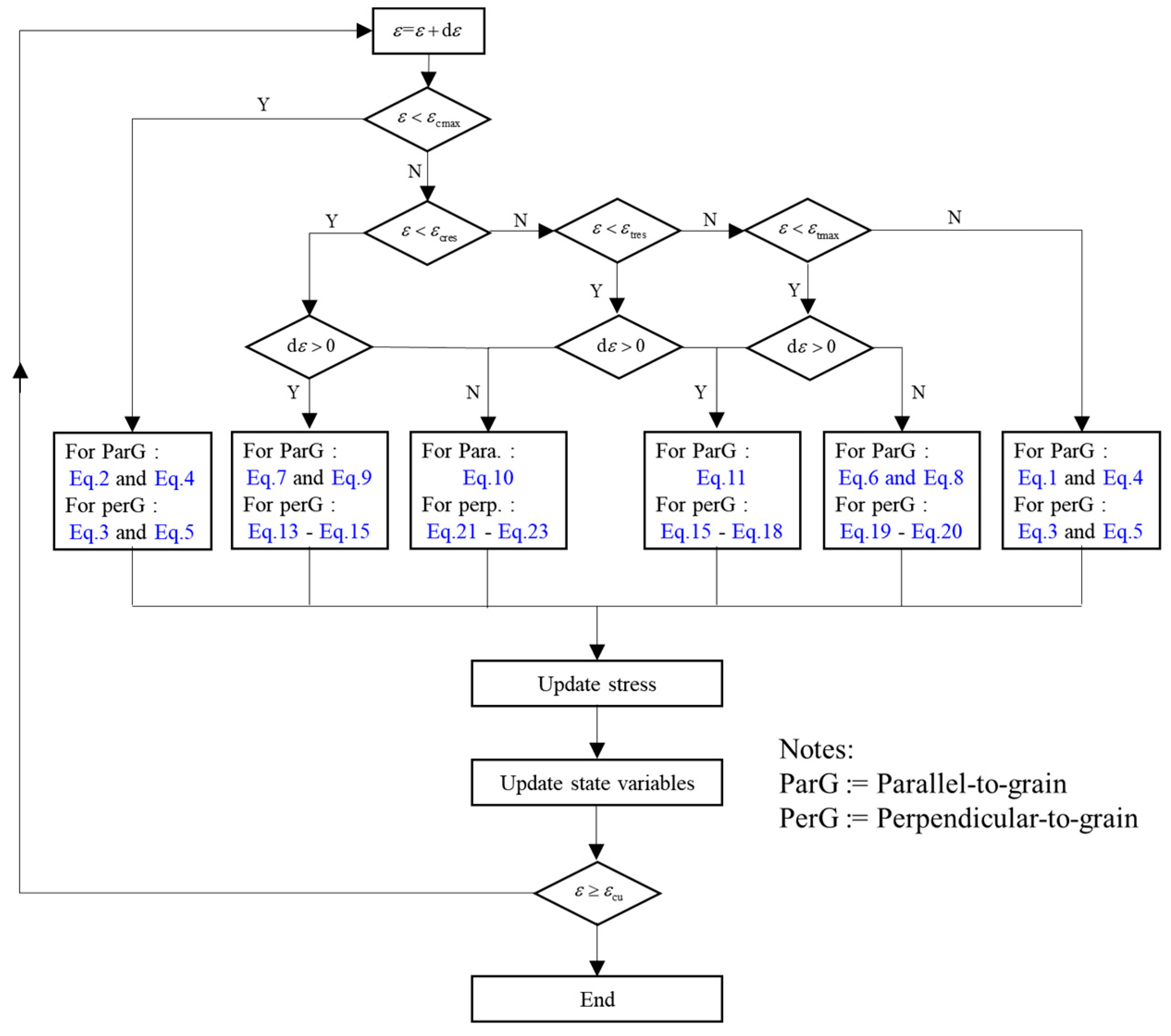
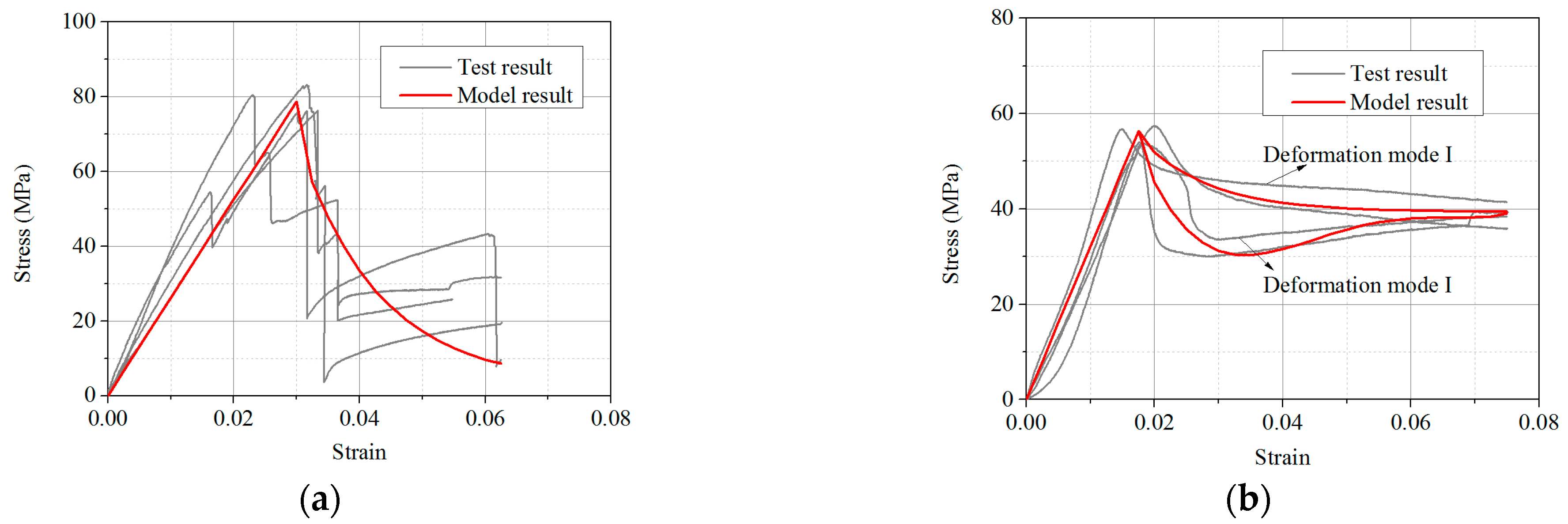
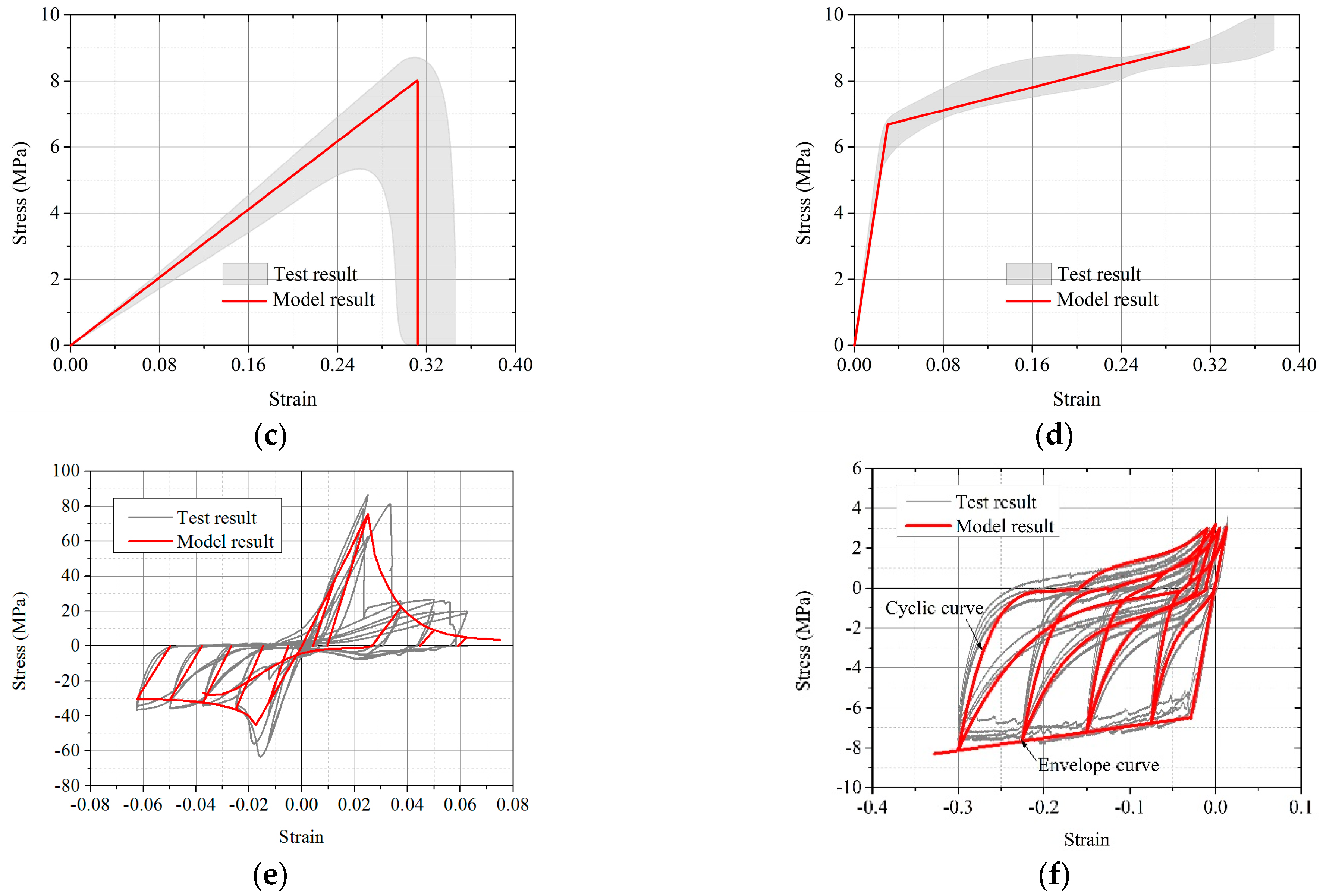
| No. | Loading Condition | Number of Specimens | |
|---|---|---|---|
| 1 | Monotonic loading | ParG tension under monotonic loading (DS1) | 4 |
| 2 | ParG compression under monotonic loading (DS2) | 4 | |
| 3 | PerG tension under monotonic loading (DR1) | 4 | |
| 4 | PerG compression under monotonic loading (DR2) | 4 | |
| 5 | Cyclic loading | ParG cyclic loading (CS1) | 4 |
| 6 | PerG cyclic loading (CR1) | 4 |
| Parameters | Parallel-to-Grain | Perpendicular-to-Grain | ||||||||
|---|---|---|---|---|---|---|---|---|---|---|
| Value | 0.82 | 0.83 | 1.0 | 0.77 | 1.0 | 0.80 | 0.86 | 0.86 | 1.0 | 0.85 |
| Unloading Point Strain | ||||||
|---|---|---|---|---|---|---|
| 0.0375 | −4.08 | 436 | −22,384 | 94,296 | 1.42 × 107 | −2.72 × 107 |
| 0.05 | −0.71 | −212 | −14,512 | 654,008 | 2.81 × 106 | −1.84 × 108 |
| 0.0625 | −1.80 | −72 | −4052 | 160,912 | 374,720 | −2.52 × 105 |
Disclaimer/Publisher’s Note: The statements, opinions and data contained in all publications are solely those of the individual author(s) and contributor(s) and not of MDPI and/or the editor(s). MDPI and/or the editor(s) disclaim responsibility for any injury to people or property resulting from any ideas, methods, instructions or products referred to in the content. |
© 2023 by the authors. Licensee MDPI, Basel, Switzerland. This article is an open access article distributed under the terms and conditions of the Creative Commons Attribution (CC BY) license (https://creativecommons.org/licenses/by/4.0/).
Share and Cite
Zhang, L.; Xie, Q.; Han, Y.; Wang, Y.; Wu, Y. Mechanical Properties of Dahurian Larch Wood under Cyclic Loading: Experiments and Constitutive Model. Buildings 2023, 13, 2256. https://doi.org/10.3390/buildings13092256
Zhang L, Xie Q, Han Y, Wang Y, Wu Y. Mechanical Properties of Dahurian Larch Wood under Cyclic Loading: Experiments and Constitutive Model. Buildings. 2023; 13(9):2256. https://doi.org/10.3390/buildings13092256
Chicago/Turabian StyleZhang, Lipeng, Qifang Xie, Yonggang Han, Yingjin Wang, and Yajie Wu. 2023. "Mechanical Properties of Dahurian Larch Wood under Cyclic Loading: Experiments and Constitutive Model" Buildings 13, no. 9: 2256. https://doi.org/10.3390/buildings13092256
APA StyleZhang, L., Xie, Q., Han, Y., Wang, Y., & Wu, Y. (2023). Mechanical Properties of Dahurian Larch Wood under Cyclic Loading: Experiments and Constitutive Model. Buildings, 13(9), 2256. https://doi.org/10.3390/buildings13092256








